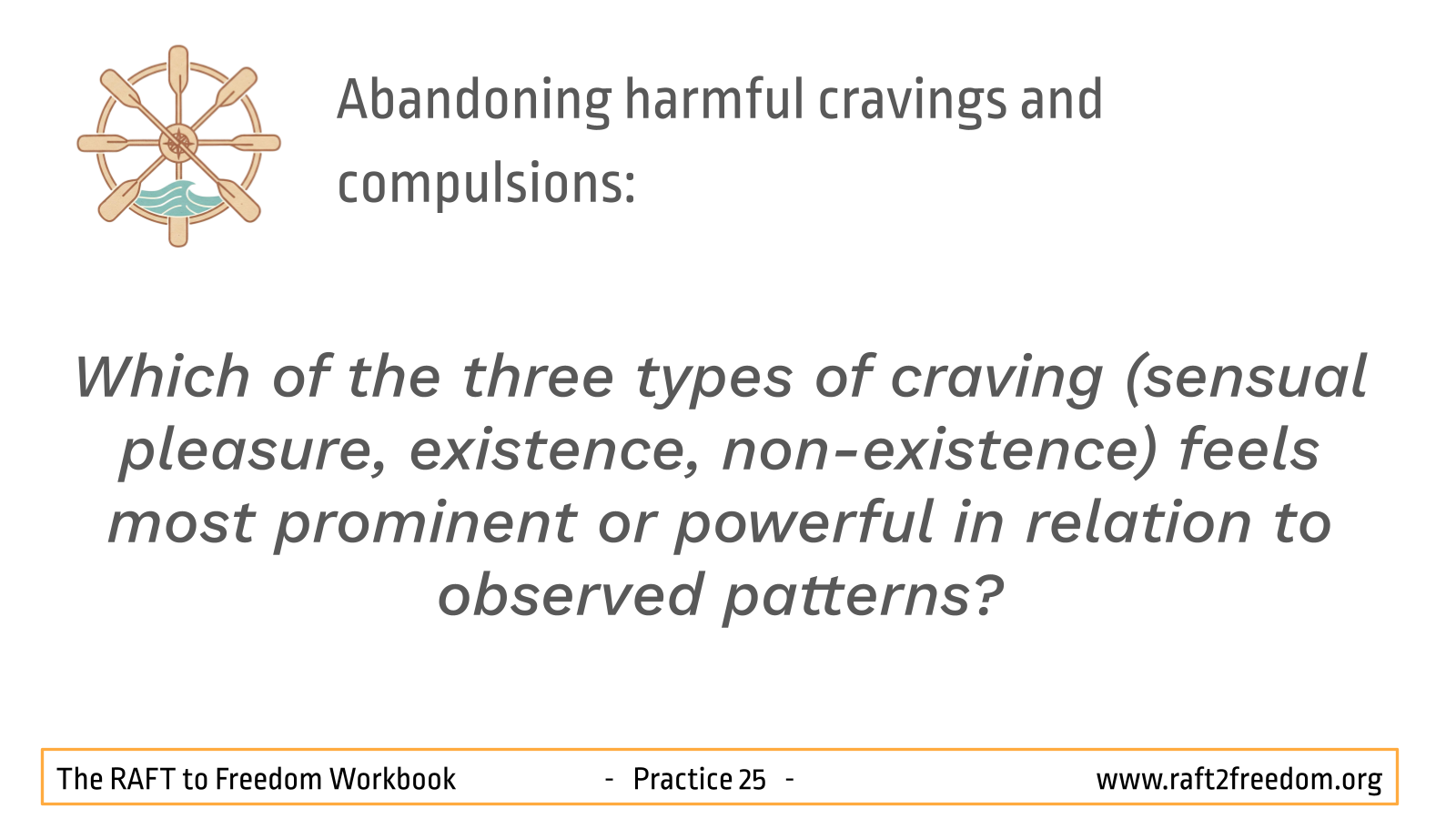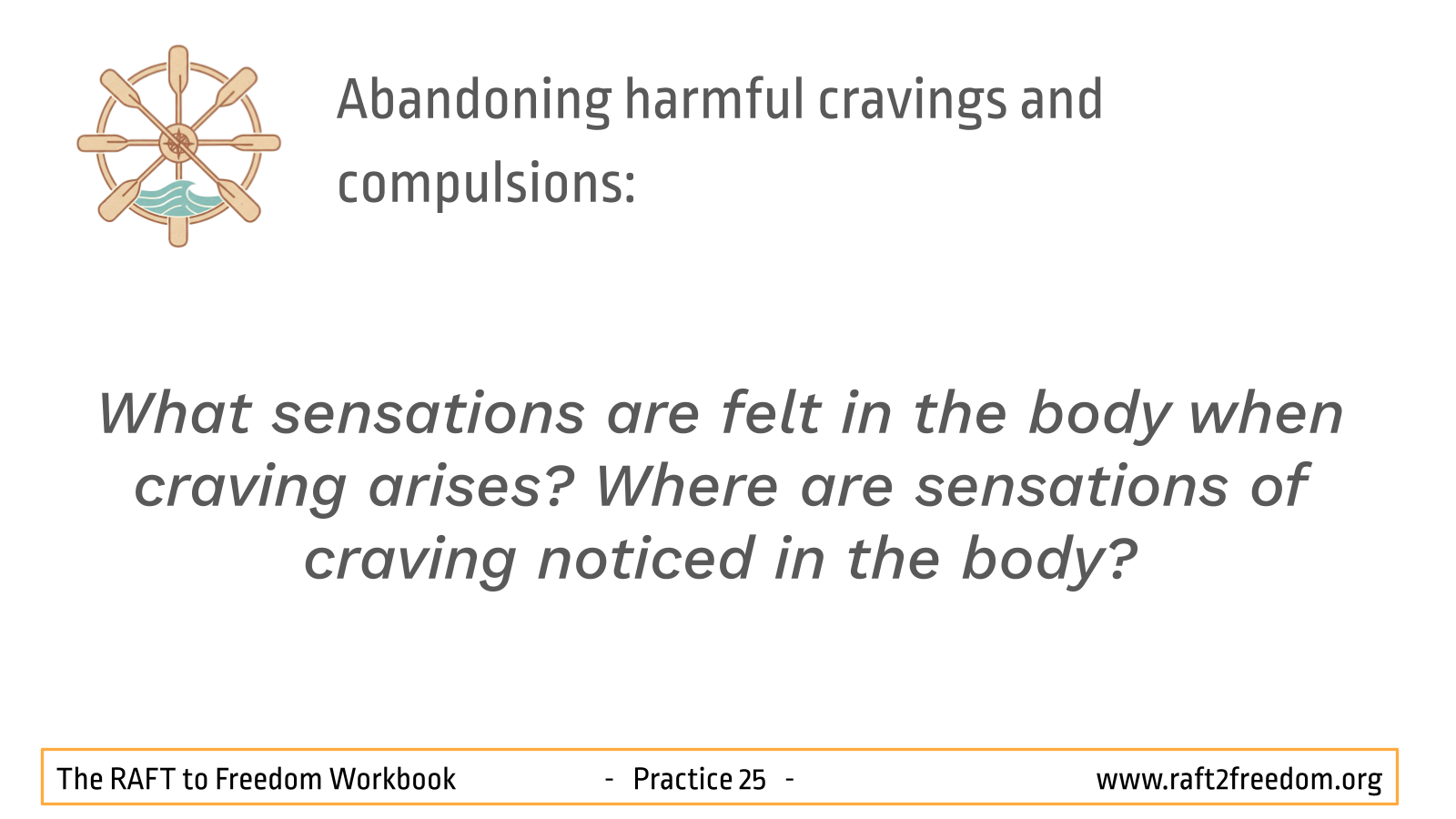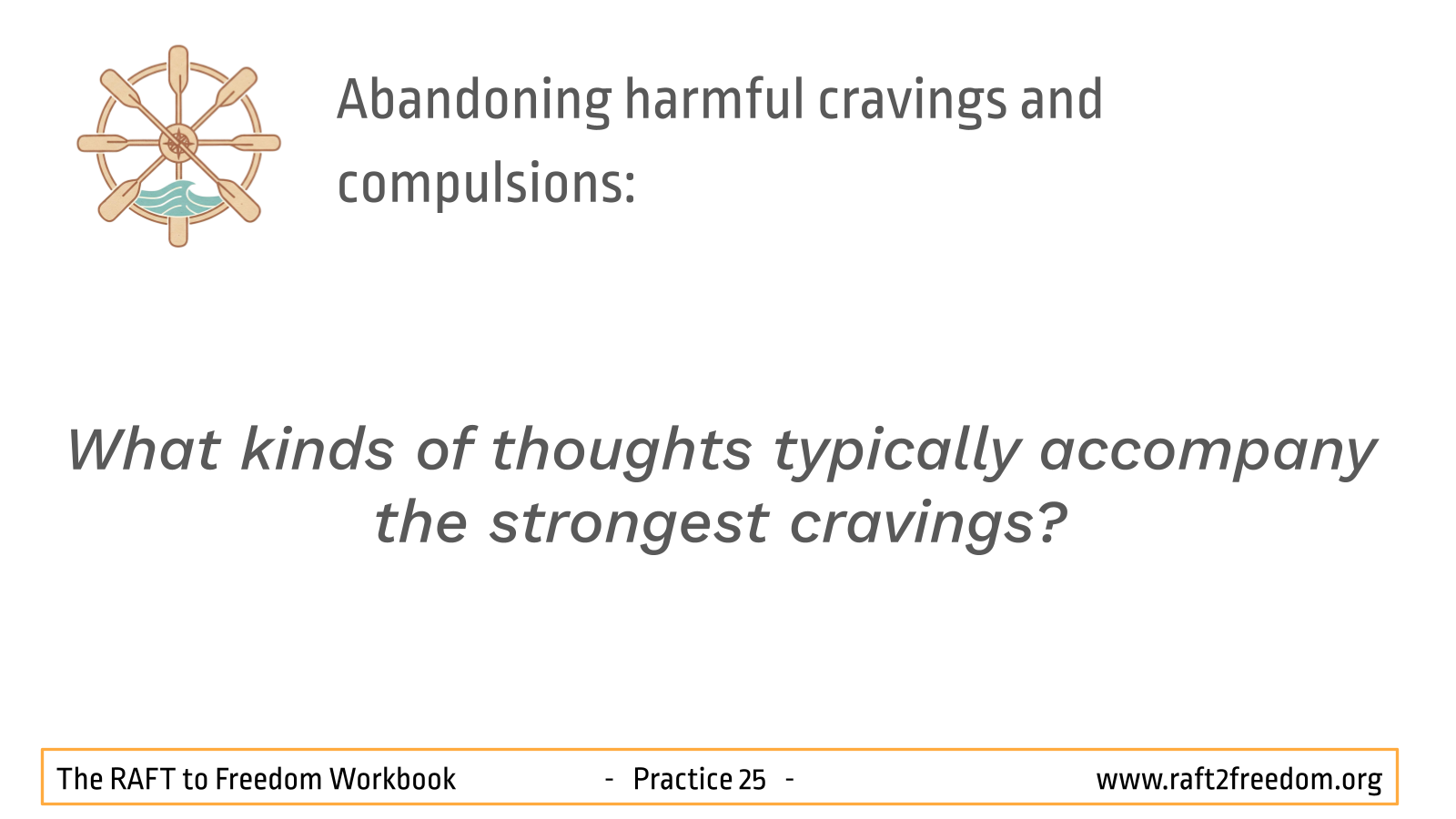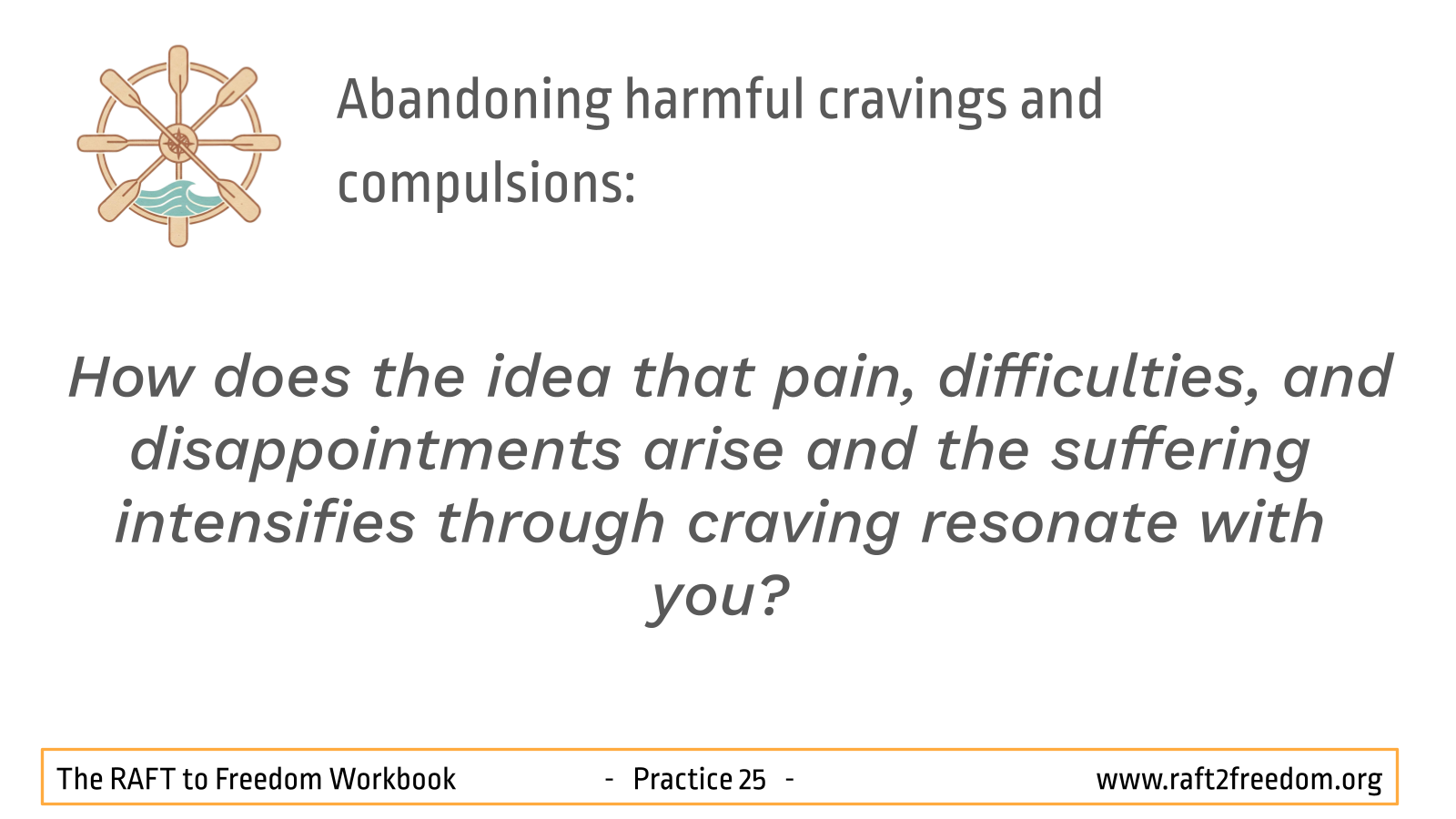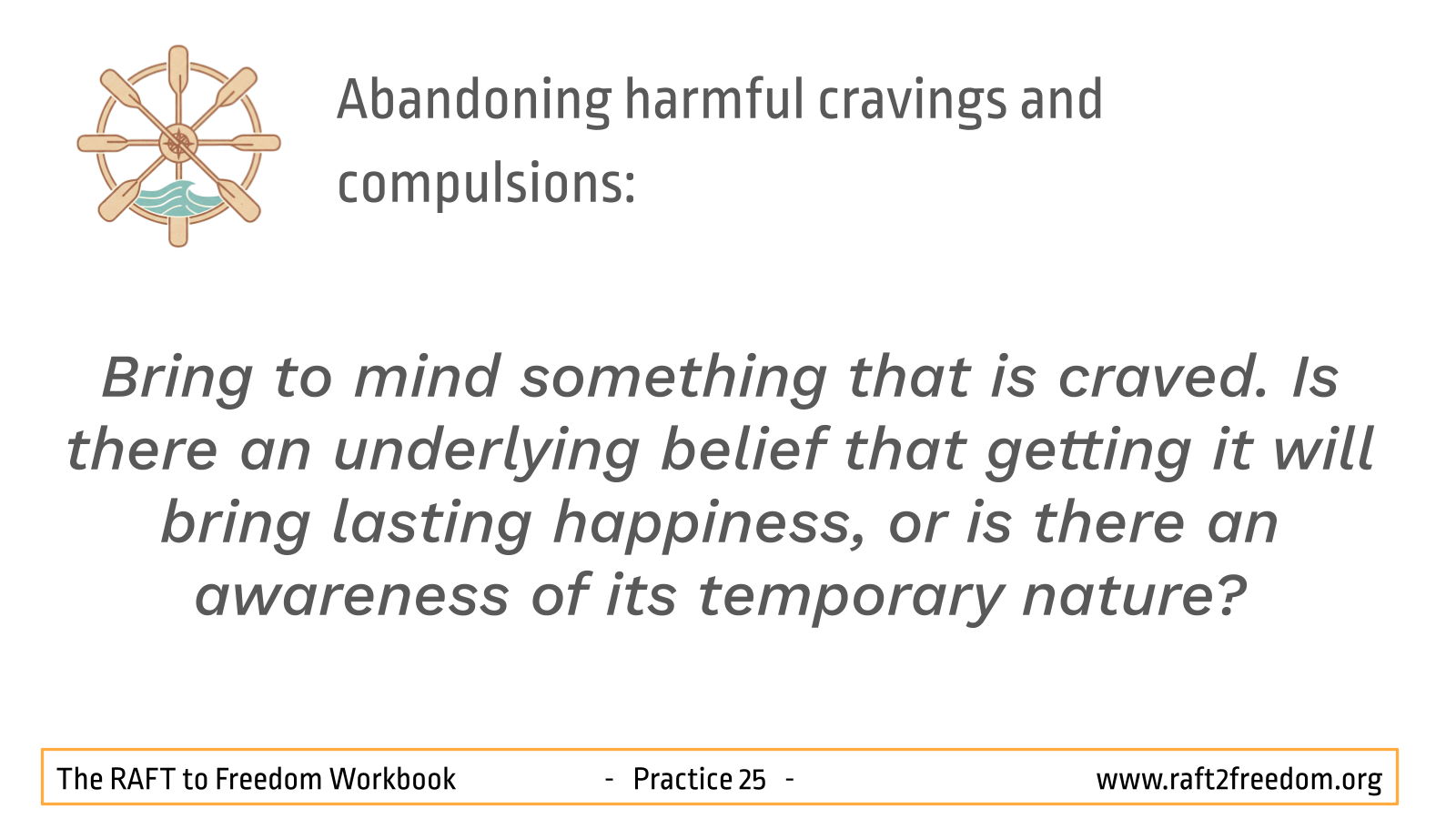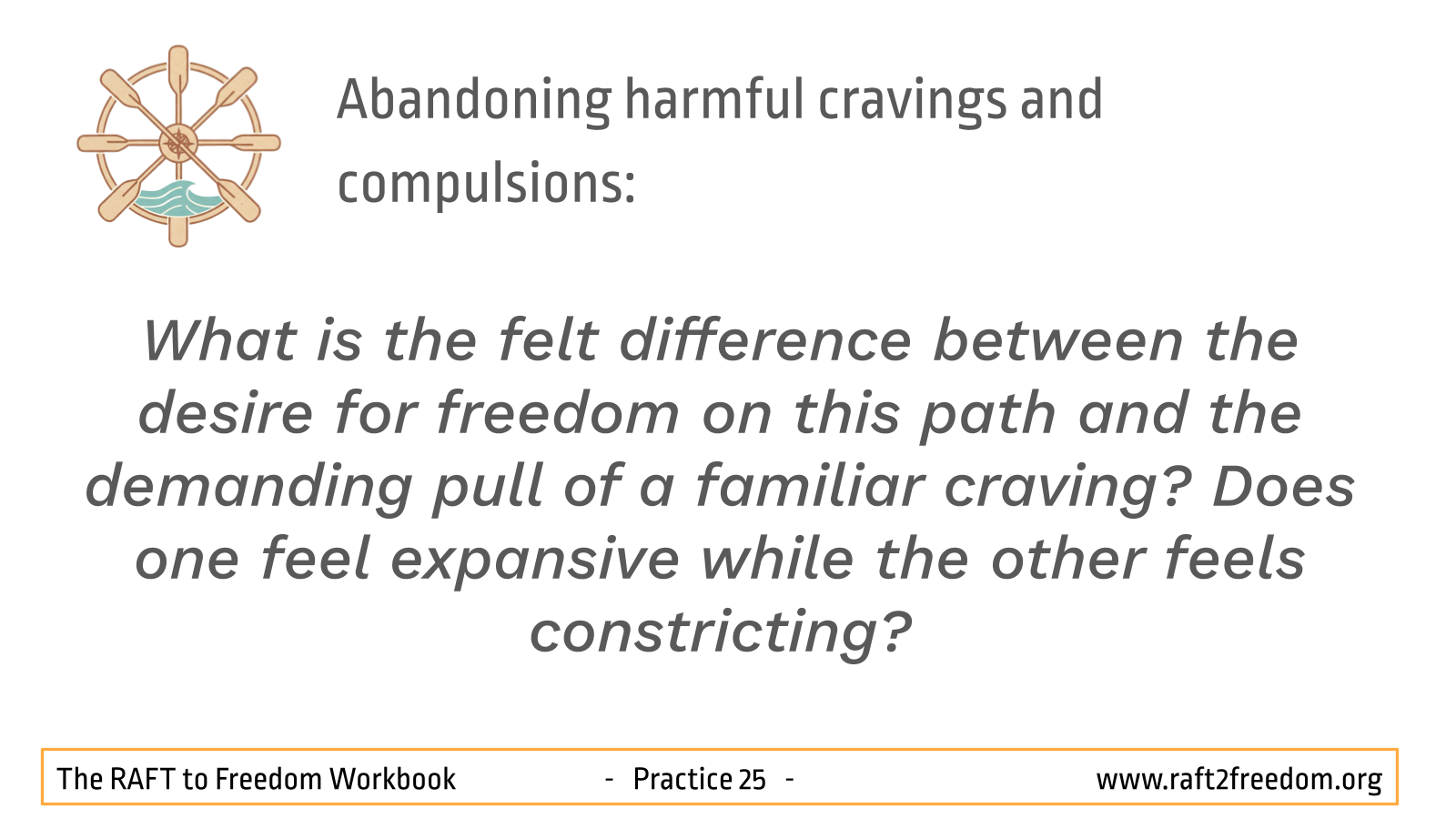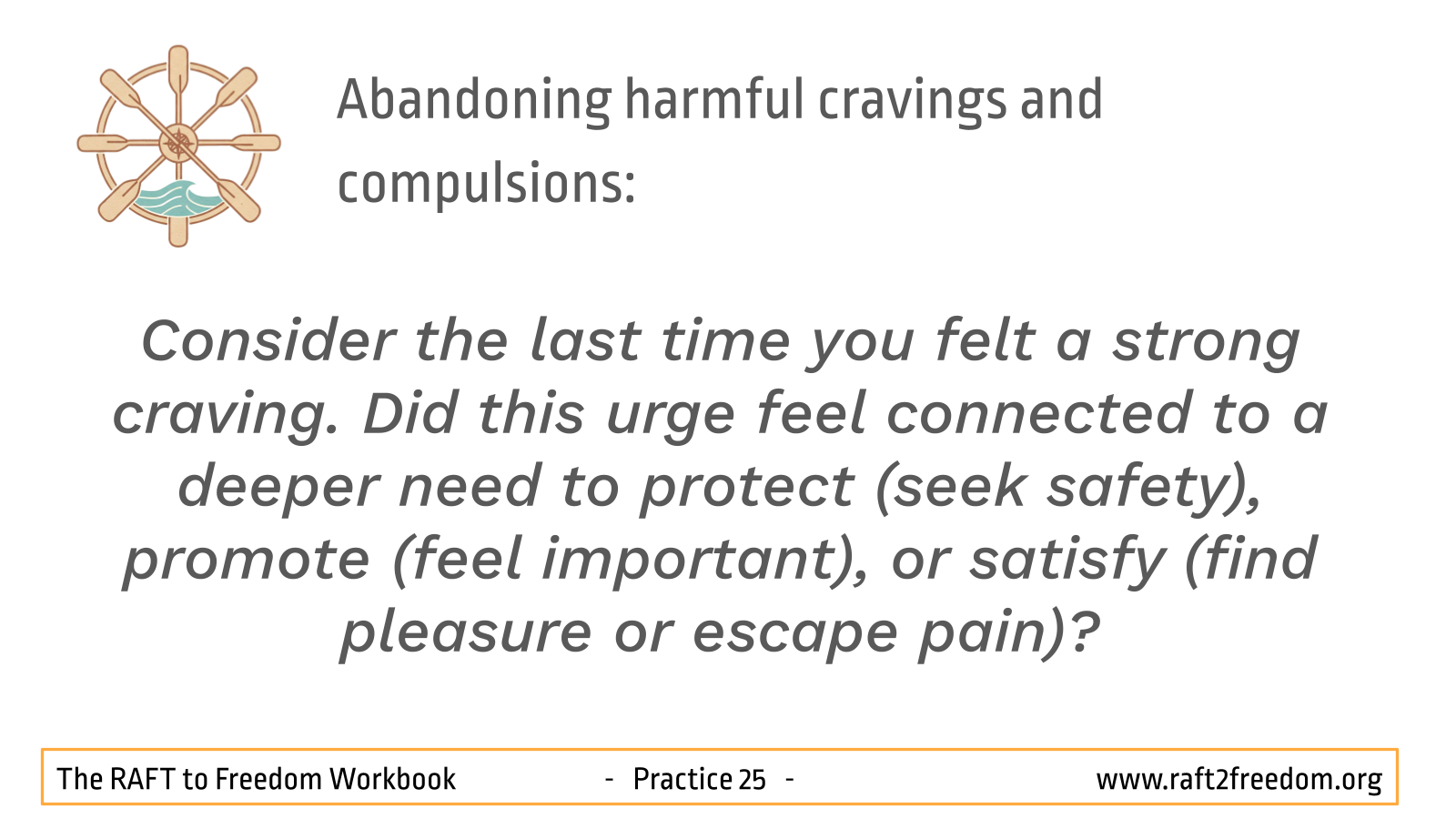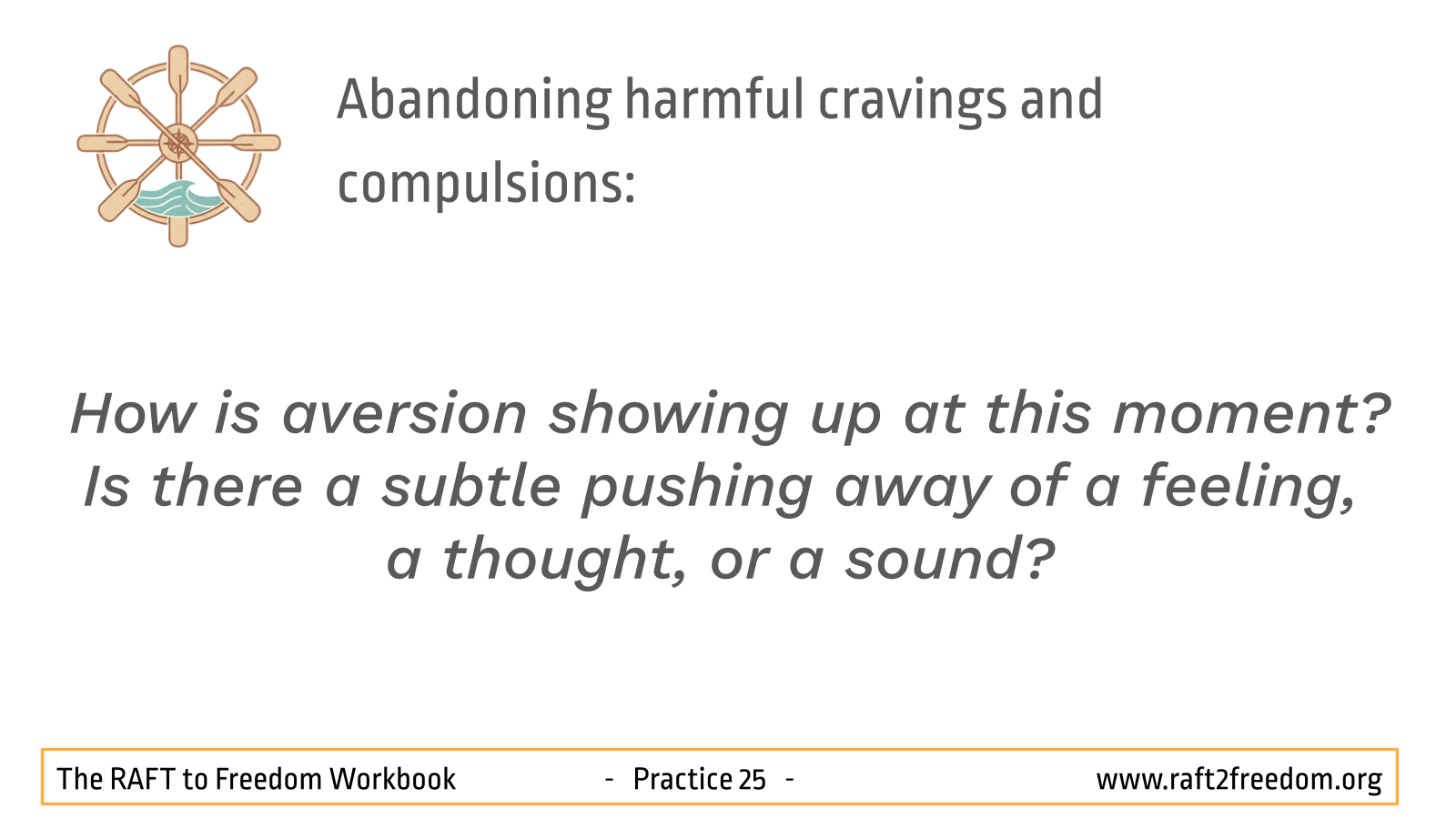25 – Abandoning harmful cravings and compulsions
You can never get enough of what you don’t really need to make you happy.
Eric Hoffer
Craving is like a thief in your house. If you do not recognise it, it will steal your peace.
Ajahn Chah

Episode 25 – A is for Abandoning
An AI generated ‘deep dive’ into this aspect of the RAFT to Freedom
Recognising the currents that pull us back
An important change of tack: letting go of ‘me’, ‘mine’, and ‘myself’
In the early stages of this journey, it’s been natural to speak in personal terms – our urges, our pain, our struggles – because that’s how experiences often feel: close, overwhelming, and deeply personal. It can seem like we’re gripping onto the raft just to stay above the water.
But as we go further along our journey, we begin to see more clearly: much of what arises – grasping, aversion, confusion – is not who we are, but rather pre-conditioned patterns passing through the mind and body, like weather through the open sky. These patterns do not truly belong to us.
From this chapter onwards, the language of the workbook gently reflects this shift. Rather than speaking of ‘my craving’ or ‘your progress,’ we will speak in ways that acknowledge this process of detachment unfolding – for example, where previously we may have written ‘our craving’ we will write ‘craving arising,’ or ‘ease returning,’ or ‘habit energy stirring’. We are beginning to acknowledge that cravings, thoughts, and emotions are often impersonal phenomena. They arise and pass based on causes and conditions, and not because of a permanent ‘me’ or ‘mine’ at their core.
By observing craving not as my craving but simply as craving arising, we create a space for mindful awareness that is less entangled with personal identity and blame, and more aligned with the universal nature of all experience. This change of tack will help us to loosen the grip of ‘self-identity’ and help us to relate to experiences with more freedom and perspective.
If familiar currents (cravings and compulsions) return, as they sometimes will – we will remember that this is the nature of the flow of the water and so it’s not personal – therefore it’s not a failure. We stay with the raft, we stay with the practice, and we remember: we are not the storm – but we are learning to ride it with wisdom.
With this shift in perspective as a new tool on the raft, the journey can now turn to the currents themselves. The next task is to identify the source of the pull that creates so much suffering.
Moving on: identifying the source of amplified suffering
Having clearly recognised life’s inherent pains, difficulties, and disappointments during the first part of our journey to freedom – which we might see as surveying the ‘dangerous shore’ – we now move to the crucial task of the second stage of our journey to ‘the far shore of liberation’: Abandoning harmful cravings and compulsions. This second leg of our journey, directly addresses Gotama (the Buddha’s) second realisation, that suffering arises and that suffering intensifies through craving.
In his foundational teaching, Gotama stated:
…the craving which leads to renewed existence, accompanied by delight and lust, seeking delight now here, now there; that is, craving for sensual pleasures, craving for existence, craving for non-existence.
This craving that Gotama described, is a deeper, often unconscious, demanding thirst or clinging. It’s the relentless ‘I need,’ ‘I must have,’ or ‘I can’t stand this’ energy that fuels our dissatisfaction and drives compulsive behaviour.
While the first part of this journey helped us to recognise the unavoidable difficulties of life (the ‘dangerous shore’ itself), Gotama’s second realisation points to how our reaction to life, driven by craving, amplifies these inherent pains, difficulties and disappointments, and creates vast amounts of unnecessary, avoidable suffering. Our human struggle with craving and avoidance, often manifesting as what is commonly called addiction, is a powerful manifestation of craving.
From a neuroscience perspective, our brains are evolutionarily predisposed to seek pleasure and novelty, which can drive the behaviours that manifest as harmful compulsions and patterns of escape. In our RAFT to Freedom metaphor, craving is the powerful underlying current that is constantly trying to pull our raft back towards the dangerous shore or into destructive whirlpools. This powerful current creates many of the leaks in our vessel (compulsive actions) and convinces us to load harmful, heavy cargo (attachments, resentments and delusions) that weigh our raft down. Understanding that craving is a natural, conditioned habit helps us to approach abandoning it with compassion and wisdom rather than shame or blame.
The three forms of craving
Gotama identified three primary forms of craving:
- Craving for sensual pleasures : This is the thirst for pleasant experiences through the six senses – sights, sounds, smells, tastes, touch, and mental objects (fantasies, thoughts). We crave stimulation, novelty, and excitement. Substance use and process behaviours which are aimed at achieving specific pleasurable states directly fuel the craving for sensual pleasures.
- Craving for existence (becoming) : This is the deep desire for continued existence, we crave identity, status, recognition, control, and for things to be a certain way permanently. It can manifest as ambition, clinging to our reputation, needing validation, or resisting change. We crave to ‘get ahead,’ sometimes at any cost, and tend to grip tightly to status, power, and wealth. Craving for existence includes yearning for ‘acquisitions’ which Gotama described as relationships and possessions that improve social status (for example, the ‘right’ social circles and always having the latest smart phone). This craving for existence can fuel compulsive behaviours related to work, power, relationships, social media, and perfectionism.
- Craving for non-existence (annihilation): This is the urge to escape our discomfort, erase feelings, or numb pain. It is the aversion, the pushing away, the wish for oblivion. This craving for non-existence strongly drives substance use as a form of escape or self-medication, as well as other avoidance behaviours. For example, we might seek oblivion through alcohol and other drugs, such as the ‘warm embrace’ of narcotics. At its extreme, craving for non-existence can manifest as a desire to end life, our own or even wishing someone else’s demise. Remember to remember – it’s strongly encouraged to seek professional help if these thoughts arise.
By recognising these cravings, we can gain greater clarity about the underlying causes of harmful patterns, this empowers us to move towards freedom.
The evolutionary roots of craving: protect, promote, and satisfy
Gotama’s insights into craving are powerfully supported by evolutionary psychology, which suggests that many of our compulsive behaviours stem from our ancient drives to survive and procreate. There are three forms of craving which are expressions of three ancient primary compulsions: to protect, to promote, and to satisfy.
- To protect: This compulsion to protect, aligns with Gotama’s craving for existence and can be understood as our deep-seated drive to stay alive and to protect the body. In modern times, this manifests not just as a need for physical safety, but also as a search for certainty and control. We create ‘castles and fortresses’ of beliefs and spend energy planning to fend off the anxiety of an uncertain future.
- To promote: The compulsion to promote is another facet of Gotama’s craving for existence, this compulsion compels us to promote ourselves. This drive for status, recognition, and validation helps to ensure we have a place in the social hierarchy. It is a natural, yet often unconscious, force behind our preoccupation with self-image and social connection. The opposite can also apply; individuals may hide or self-isolate out of a need to protect.
- To satisfy: This compulsion to satisfy covers both craving for sensual pleasures and craving for non-existence. It is rooted in our ancient need to satisfy and regulate the body-mind process. Whether it is seeking fleeting pleasure or trying to escape discomfort and pain, this compulsion drives us to seek external stimuli or internal states that promise us a sense of relief.
As we explored in the second chapter of the workbook, the young Gotama lived lavishly, wearing only the finest underwear, clothes and perfumes. He had three houses and spent the four months of the rainy season being entertained by female minstrels without a single man among them – he reflected that he did not once leave the house! His privileged and luxurious life included many pleasures and acquisitions that included “spouses & children, male and female slaves, goats & sheep, fowl & pigs, elephants, cattle, horses & mares, and gold & silver”.
This illustrates his status and wealth at the time, but Gotama became disillusioned with this lifestyle and the accompanying responsibility to maintain it. After he left home and ‘abandoned’ these many ‘acquisitions’ and obligations, he eventually woke up to life as it really is – including the suffering amplified by these three types of craving.
The universality of craving for safety and certainty was insightfully presented by Gotama as the ‘Four Summaries’. They can be paraphrased something like this:
- The world is unstable and I can be swept away at any moment.
- The world has no shelter and no protector; no saviour.
- The world has no owner – it doesn’t matter how many ‘acquisitions’ – I must leave everything behind.
- The world is lacking, wanting, insatiable, making me the slave of craving.
Seeing through the perspective of these ancient roots, helps to depersonalise our struggle, it reveals these compulsions as a shared, human inheritance rather than an individual failing. While these instincts were once essential for our survival, they now often lead to the compulsive, repetitive cycle of dissatisfaction. None of these compulsions result in a permanent or lasting satisfaction, which compels us to repeat the same compulsions over and over again. The American psychologist Rick Hanson says:
“At the most basic, microscopic level, it is the nature of mind to cling. As a strategy for passing on genes, it has worked spectacularly well. But Mother Nature doesn’t care if we suffer; she only cares about grandchildren!”.
Let reactivity be: the practice of abandoning
When craving arises, reactivity can be an automatic response. In this stage of our journey, our practice is to learn not to feed this reactivity, but to let it be and let it go. Often, thought patterns amplify and catastrophise the experience, putting fuel on the fire and increasing the anxiety, neediness, or other strong emotions. If reactivity is not fed, it will gradually lessen, and the mind becomes quieter and clearer. This crucial step is supported in this stage of our journey, by the Five Defenders of Liberation – Confidence, Courageous Effort, Mindfulness, a Gathered Mind, and Discernment (to be explored in upcoming chapters).
A simple way to practise letting reactivity be is to observe a craving as it arises, pause, and instead of immediately acting on it, notice the physical sensations in the body and the thoughts in the mind. Acknowledge the urge without judgement and gently remind yourself: ‘This is a craving arising, and it will pass.’ Stay present with the experience, knowing you do not have to obey its command. This creates a crucial gap between stimulus and response, allowing for wiser choices.
How to let reactivity be.
- Keep a craving inventory: Reflecting each day on the situations, thoughts, or emotions that triggered craving, and identifying what fuelled each urge. This may be boredom, stress, or a desire for comfort. We can categorise them under the three forms of craving taught by Gotama: for pleasure, for existence, and for non-existence. This clarity allows us to change the conditions that feed craving.
- Practise mindful observation of cravings: Pausing when an urge appears, bringing attention to the breath, noticing sensations in the body – perhaps tightness, restlessness, or warmth – and naming the experience gently (‘wanting,’ ‘pulling,’ ‘urge’) as we watch it arise, change, and fade. This reveals the impermanent nature of craving and diminishes its power.
- Cultivate acceptance and equanimity: Meeting cravings without suppression or indulgence. Instead of fighting, we breathe, visualise the urge like passing weather, and remind ourselves, ‘This will pass.’ This balanced presence weakens the craving’s hold and builds resilience.
- Replace unhelpful habits with wholesome alternatives: Engaging in healthy behaviours such as meditation, journaling, exercise, movement, or creative pursuits that meet the same underlying need without harm. This is the practical application of the resolve to abandon and the resolve to cultivate.
- Engage in compassionate reflection on setbacks: Recognising that lapses are part of the journey. We approach them without self-blame, instead applying Fearless Investigation to understand what happened and how we can respond more skilfully next time. This breaks the shame–craving cycle.
- Seek community support: Regularly connecting with trusted friends, mentors, or support groups. Spiritual friendships strengthen our resolve, and offer us accountability. This reminds us that we are not alone in our practice.
We can also draw on additional Buddhist inspired methods to deepen our capacity to let reactivity be:
- Contemplation of impermanence: Reminding ourselves that all cravings pass.
- Contemplation of unsatisfactoriness: Recalling how past cravings failed to bring lasting happiness.
- Contemplation of not-self: Seeing craving as a passing event, not as ‘me’ or ‘mine.’
- Five remembrances reflection: We can place momentary urges in the broader context of life’s fragility:
- I am of the nature to grow old; I have not gone beyond ageing.
- I am of the nature to become ill; I have not gone beyond illness.
- I am of the nature to die; I have not gone beyond death.
- All that is dear to me and everyone I love are of the nature to change; there is no way to escape being separated from them.
- My actions are my only true belongings; I cannot escape the consequences of my actions.
- Loving-kindness for the urge: Befriending our experience and the part of ourselves that craves – the appropriate response for this second stage of our journey to freedom.
- Guarding the sense doors: Being mindful about what we allow into our awareness, reduces the likelihood of craving arising in the first place.
Through these practices, we develop the ability to meet craving with wisdom and kindness. We shift from being controlled by our impulses to choosing actions that align with freedom. This is how we train ourselves, step by step, to let reactivity be and to abandon harmful cravings and compulsions.
Self-reflections
Consider how craving manifests in experience:
- Which of the three types of craving (sensual pleasure, existence, non-existence) feels most prominent or powerful in relation to observed patterns?
- What sensations are felt in the body when craving arises? Where are sensations of craving noticed in the body?
- What kinds of thoughts typically accompany the strongest cravings?
- How does the idea that pain, difficulties, and disappointments arise and the suffering intensifies through craving resonate with you?
- Bring to mind something that is craved. Is there an underlying belief that getting it will bring lasting happiness, or is there an awareness of its temporary nature?
- What is the felt difference between the desire for freedom on this path and the demanding pull of a familiar craving? Does one feel expansive while the other feels constricting?
- Consider the last time you felt a strong craving. Did this urge feel connected to a deeper need to protect (seek safety), promote (feel important), or satisfy (find pleasure or escape pain)?
- How is aversion showing up at this moment? Is there a subtle pushing away of a feeling, a thought, or a sound?
Journaling prompts
Use writing to investigate craving:
- Craving inventory: For a day or two, consciously note down instances of craving as they arise. What was the object? What type of craving was it (protect, promote, satisfy)? What triggered it? What sensations and thoughts were present? Was there an action on it? What happened next?
- The amplification effect: Think of a recent difficult experience (a disappointment, physical pain, conflict). How did craving (for example, craving for it to be different, for escape, or for comfort) potentially add to the suffering of that initial difficulty?
- Questioning assumptions: Challenge beliefs related to cravings (for example, ‘This is needed to cope,’ ‘This feeling is unbearable’).
- Learning from setbacks: Analyse a recent setback compassionately. What contributed to it? How can it be approached differently next time?
- Wholesome desire versus craving: Clarify wholesome desires (chanda) and how they differ from harmful cravings (taṇhā).
Supporting material: scientific and philosophical perspectives
For those interested in the scientific and philosophical underpinnings of abandoning harmful cravings and compulsions, the following overview highlights some key connections.
- Neuroscience: Craving hijacks the brain’s reward pathways, reinforcing compulsive behaviours through dopamine release. The brain’s reward system, involving the dopaminergic circuitry, is activated by cues (triggers), releasing dopamine and reinforcing the drive to repeat pleasurable, often harmful, behaviours. Mindfulness practices help to rewire these neural pathways, promoting greater self-control and reduced reactivity. Neuroplasticity allows for the formation of new pathways through repeated skillful responses, and mindfulness meditation has been shown to reduce reactivity in brain regions associated with craving (for example, the insula and prefrontal cortex). Chronic stress also increases cortisol levels, which magnifies craving and impulsivity; regular mindfulness practice can lower stress reactivity.
- Psychology: Learning Theory explains how cravings become associated with triggers and are reinforced by temporary relief or pleasure. Cognitive theories explore the distorted thoughts and beliefs that fuel craving (‘This cannot be handled without X’). Acceptance-based therapies like Mindfulness-Based Relapse Prevention (MBRP) and Acceptance and Commitment Therapy (ACT) focus on changing one’s relationship to craving – observing and accepting its presence without needing to act on it. Unresolved emotional pain often lies beneath craving, and developing emotional literacy and self-compassion weakens the cycle of using substances or behaviours for relief.
- Philosophy: Gotama’s insights into craving align closely with Stoicism and Virtue Ethics, both of which advocate for the recognition and restraint of harmful desires. The paradox of craving is highlighted: pursuing what cannot truly satisfy leads to suffering. The Buddhist view of non-self encourages letting go of rigid self-identification with cravings, recognising that urges do not define the self, which opens a pathway to freedom. Training in virtues (such as harmlessness, kindness, equanimity, self-discipline) is advocated as the basis for sustained freedom from compulsion.
Remember to remember
This second stage of our RAFT to freedom journey – Abandoning harmful cravings and compulsions – is fundamental to our liberation. Gotama’s second realisation – that suffering arises and that suffering intensifies through craving – offers profound insight: the primary engine driving suffering, including what is known as addiction, is craving in its various forms. It helps distinguish between the unavoidable difficulties of life and the vast, avoidable suffering generated by craving. Recognising this allows us to shift from battling symptoms or blaming ourselves to addressing the root cause with wisdom and skill. This crucial abandonment is guided by the ‘Four Resolves’ – especially the resolve to abandon unwholesome states and cultivate wholesome ones – which direct our effort with precision.
We learn to observe rather than obey cravings, replacing harmful compulsions with skillful, beneficial habits. This abandonment is not about suppression but about mindful awareness and wise choice, creating lasting freedom from destructive cycles. By courageously examining and compassionately responding to cravings, we build resilience and pave the way toward genuine peace and liberation.
Before we delve into the specific strategies for abandoning, however, it is essential to cultivate the appropriate response for this challenging work. The next chapter will introduce Befriending as the vital attitude of friendliness and self-compassion needed to meet our cravings and ourselves with the kindness that facilitates true letting go.
Letting go gives us freedom, and freedom is the only condition for happiness.
Thich Nhat Hanh
You can’t stop the waves, but you can learn to surf.
Jon Kabat-Zinn
Sutta references
- Dhammacakkappavattana Sutta (SN 56.11): Setting the wheel of Dhamma in motion
- Summary: This is the foundational text defining the Second Noble Truth. It explicitly identifies the origin of suffering as taṇhā (craving) – specifically for sensual pleasures, existence, and non-existence – which leads to renewed becoming and is accompanied by delight and lust.
- Dvedhāvitakka Sutta (MN 19): Two sorts of thinking
- Summary: This sutta guides practitioners in distinguishing between beneficial and harmful thoughts, emphasising abandoning harmful desires.
- Dhammapada, Chapter 24 (Craving): The Buddha’s path of wisdom
- Summary: This chapter contains numerous verses on the nature and consequences of craving. It depicts craving as a creeping vine that ensnares, emphasising that cutting its root leads to freedom from sorrow and suffering.
RAFT to Freedom © 2025 by Dr Cathryn Jacob and Vince Cullen is licensed under CC BY-NC-SA 4.0. To view a copy of this license, visit https://creativecommons.org/licenses/by-nc-sa/4.0/ |
